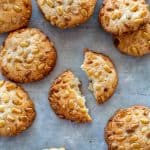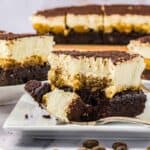Italian Ricotta Cheesecake
This silky-smooth, crustless ricotta cheesecake combines cream cheese with whole milk ricotta for a simple dessert that has all the creaminess of New York style cheesecake with the lightness of Italian style cheesecake. It's one of my family's favorite dessert recipes and it will become one of yours, too!
This post may contain affiliate links.
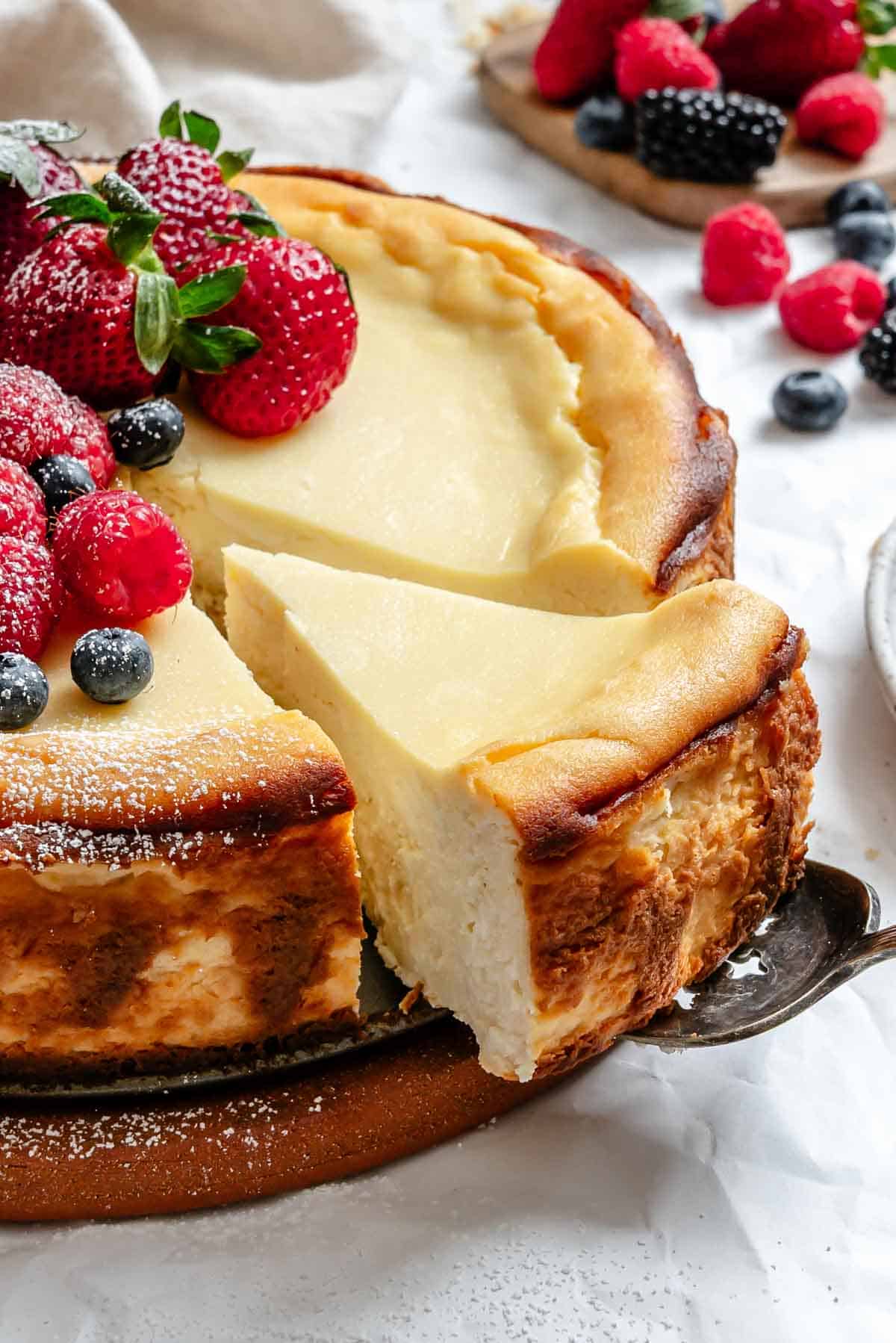
You'll Love This Recipe for Ricotta Cheesecake
This Italian ricotta cheesecake recipe comes from my Aunt Angela, who often hosts our family gatherings. It's become a staple at celebrations, especially Easter, along with our Sunday Sugo (Gravy), and was inspired by our Sicilian roots.
Popular throughout Southern Italy, especially Sicily, ricotta cheesecakes have been made for generations using simple ingredients that showcase the region's incredible dairy.
This recipe combines the lightness of classic Italian cheesecake and the creaminess of American versions. By combining ricotta with cream cheese, you get an airy cheesecake that's delicate like an authentic Italian ricotta cake, yet still delivers the rich, luxurious texture expected from a cream cheese cheesecake.
Unlike regular cheesecake or New York-style cheesecake with their graham cracker bases, this Sicilian ricotta cheesecake recipe is crustless, letting the velvety filling take center stage.
The best part? No crust means it's quicker and easier to make, not to mention there's no fussy water bath required! Instead, it uses a simple slow cooling method to help prevent cracks.
If you've ever been intimidated by the idea of baking a classic cheesecake for the first time, this is the recipe for you!
Want more delicious Italian desserts made with ricotta? Try my Sicilian ricotta cannoli filling with its perfectly balanced sweetness, this tender ricotta cake studded with juicy pears or my classic Italian ricotta pie that's traditional for Easter.
Why This Recipe Works
- The combination of cream cheese and ricotta creates the perfect balance of texture and flavor.
- No crust makes it easier to prepare and let's the filling shine.
- The slow cooling method prevents cracking without a water bath.
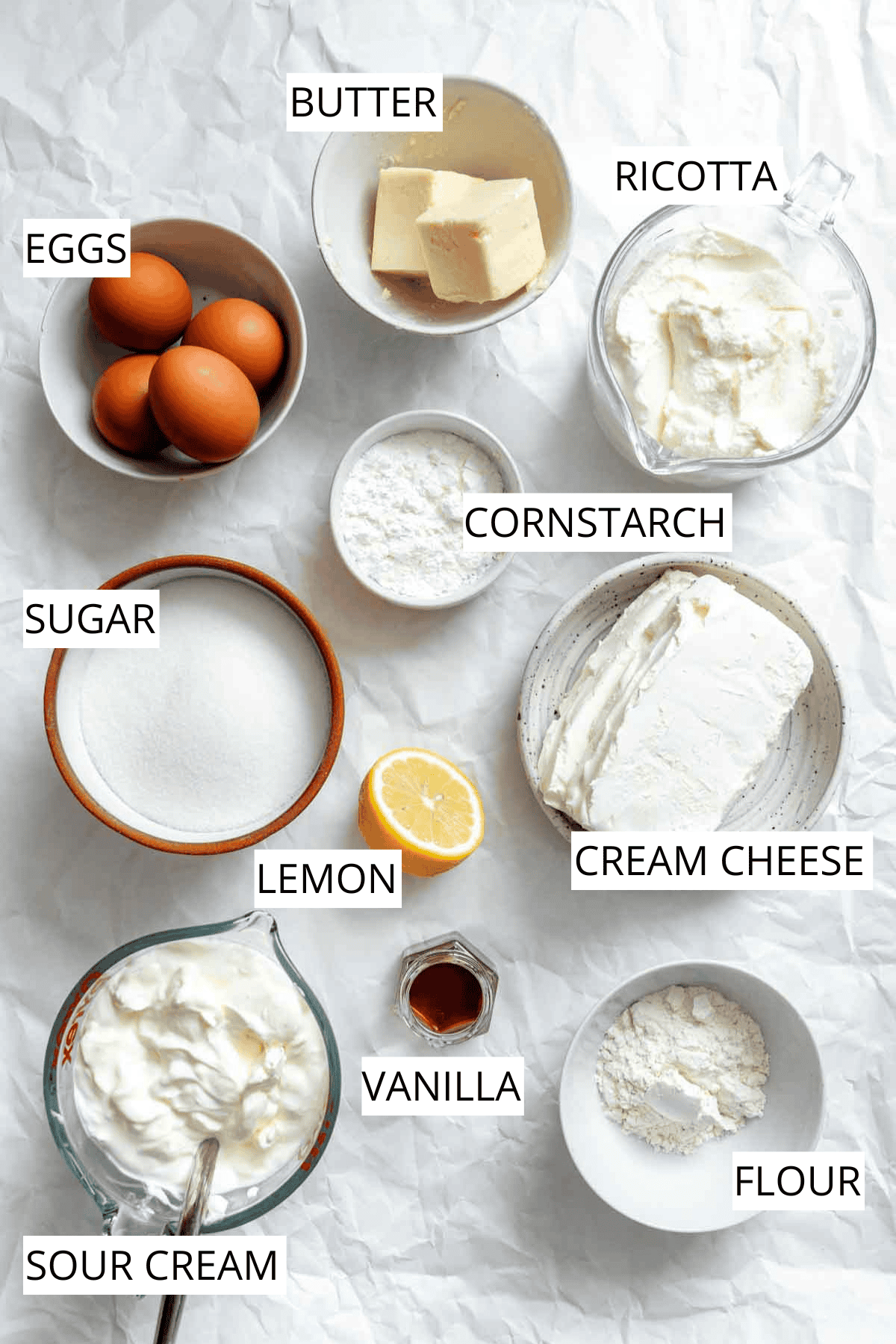
Ricotta Cheesecake Ingredient Notes
Ricotta cheese - Whole milk ricotta cheese is essential. If it seems wet, create drained ricotta using a fine-mesh sieve for an hour before using. Try it with my homemade ricotta! You can learn more about quality ricotta and other Italian cheeses in my guide.
Cream cheese - Use full-fat, brick-style cream cheese for best results. Do not substitute low-fat versions like neufchâtel, or it will affect the texture. Let it soften completely to prevent lumps in your cheesecake batter.
Eggs - Use room temperature eggs to make sure they incorporate properly. This recipe uses whole eggs, so there's need to separate the egg whites and egg yolks!
Vanilla extract - Adds just the right amount of flavor. Use a high quality extract or try making my homemade vanilla extract!
Lemon juice - Just a tablespoon brightens without making it lemony. If you want more citrusy flavor, add some lemon zest or orange zest.
Cornstarch and flour - These Italian baking essentials provide structure and help prevent cracking.
Sour cream - Be sure to use full-fat sour cream.
*Find the full ingredient list in the recipe card below!
Helpful Equipment
- 9-inch springform pan
- Electric mixer or stand mixer with paddle attachment
- Large mixing bowl
- Rubber spatula or wooden spoon
- Parchment paper (optional)
How to Make Italian Ricotta Cheesecake

- Start by preheating your oven to 350°F and greasing a 9-inch springform pan with butter or cooking spray.
- The first step for making the batter is to beat the cream cheese and ricotta together until completely smooth using an electric mixer on medium speed. This forms the base of your cheesecake, so take your time to ensure there are no lumps.
- Add the sugar, eggs, lemon juice, vanilla, cornstarch, flour, melted butter, and sour cream to the bowl. Mix until just combined and smooth, but be careful not to overmix.
Pro Tip: Overmixing incorporates too much air into the batter, which can cause cracking. If using a stand mixer, use the paddle attachment on medium-low speed.

- Pour batter into the prepared pan and smooth the top. Gently tap the pan on the counter a few times to release any trapped air bubbles.
- Place pan on a 350°F hot oven and bake for an hour. The center will still be quite jiggly when you turn off the oven - this is exactly what you want. Leave the cake inside the closed oven for another hour to cool gradually.
- Let the baked cheesecake cool completely at room temperature, then refrigerate for at least 8 hours or overnight.
Pro Tip: For clean, perfect slices, dip your knife in hot water and wipe it clean between cuts.
- When ready to serve, gently release the sides of the springform pan. If the cake sticks, run a knife dipped in hot water around the sides of the cake pan to help it release.
- Serve with fresh berries or a light dusting of powdered sugar!
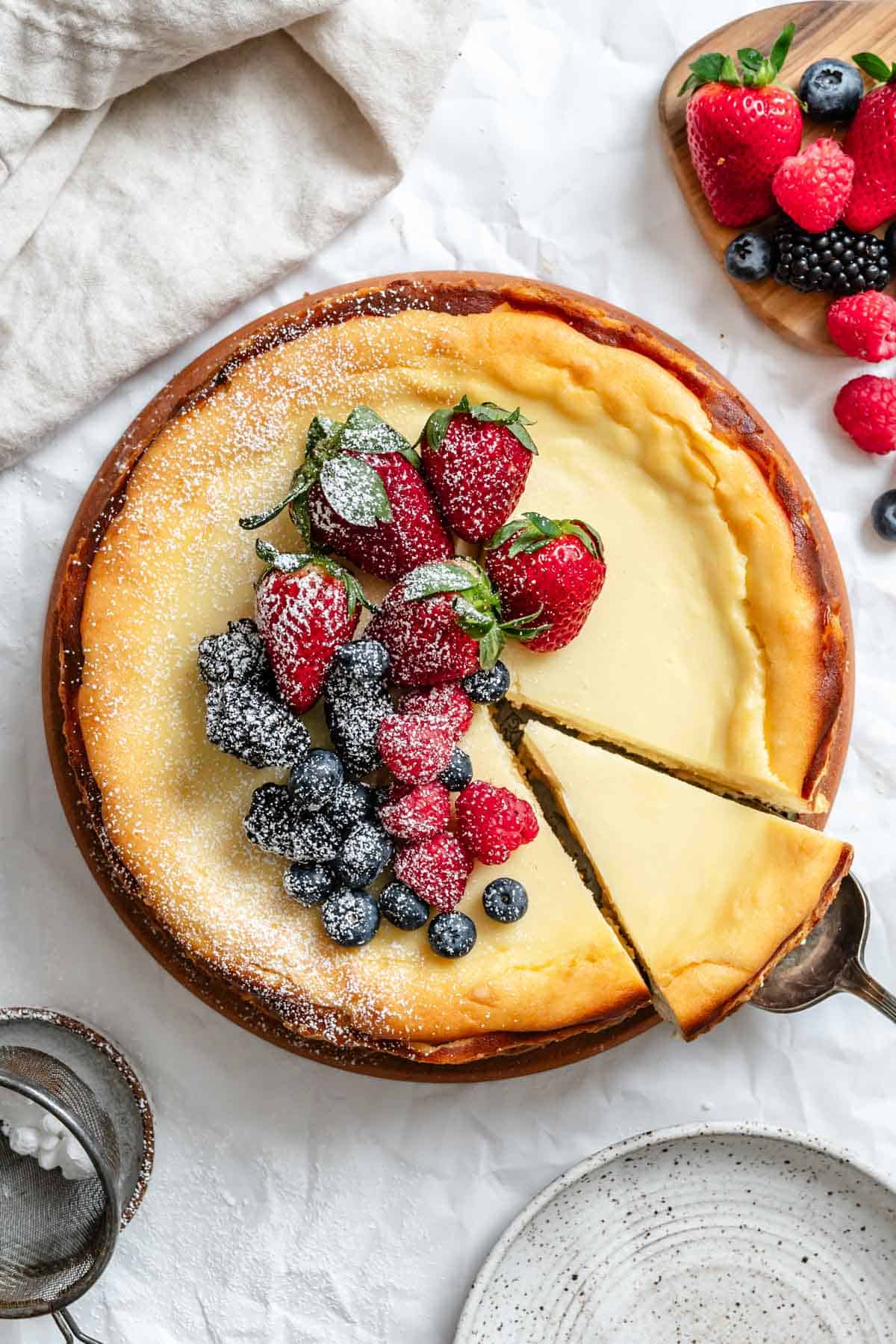
Tips for Success
- Ensure all ingredients are at room temperature. Cold ingredients create lumps.
- Don't over whip after you incorporate eggs to avoid adding too much air.
- Chill thoroughly overnight before slicing.
Crustless Ricotta Cheesecake Variations
- Add lemon zest, orange zest or almond extract for more traditional Sicilian cheesecake.
- Line the pan with a graham cracker crust or cookie crust before filling.
- Bake seasonal fruit into the top of the cake, like my Plum Cheesecake.
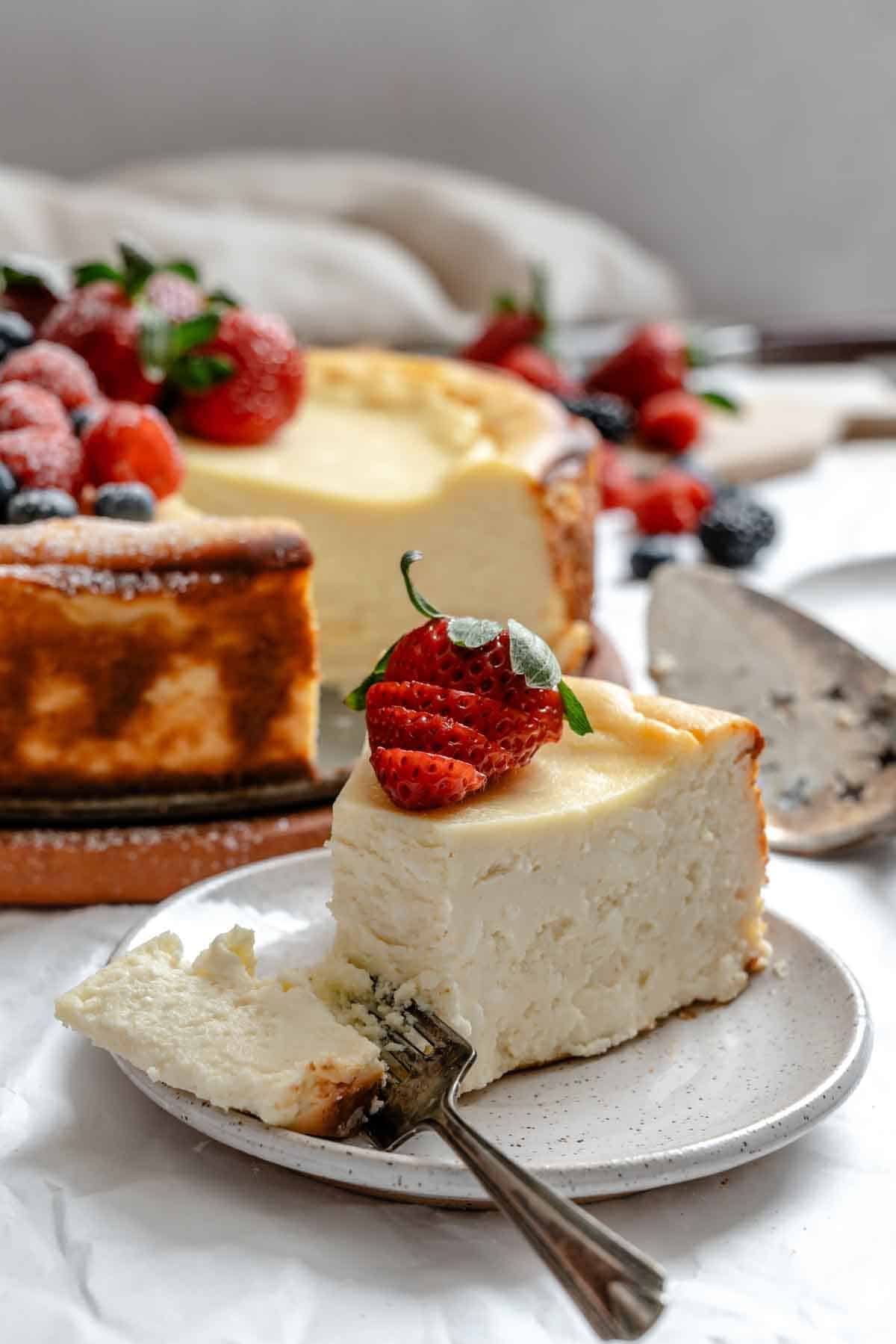
Serving Suggestions
Top with seasonal fresh fruit like juicy fresh berries or fresh figs. Or, try a tangy blueberry sauce or blueberry compote to enhance the overall flavor.
This baked ricotta cheesecake makes a spectacular finale to any special Italian dinner.
Serve it after these savory dishes, like tender Sunday Braciole, slow-simmered Italian meatballs, classic Tagliatelle with Ragu alla Bolognese, a traditional seafood stew like Cioppino, or a simple, golden brown Easy Baked Flounder Oreganata.
Serve with strong espresso or a classic Affogato for the perfect finishing touch!
How to Store Italian Ricotta Cheesecake
It will keep in the refrigerator for up to 5 days. Press plastic wrap against cut edges, then cover with aluminum foil or place individual slices in an airtight container.
You can freeze for up to 2 months. Wrap tightly in plastic wrap, then aluminum foil. Thaw in the refrigerator before serving next time.
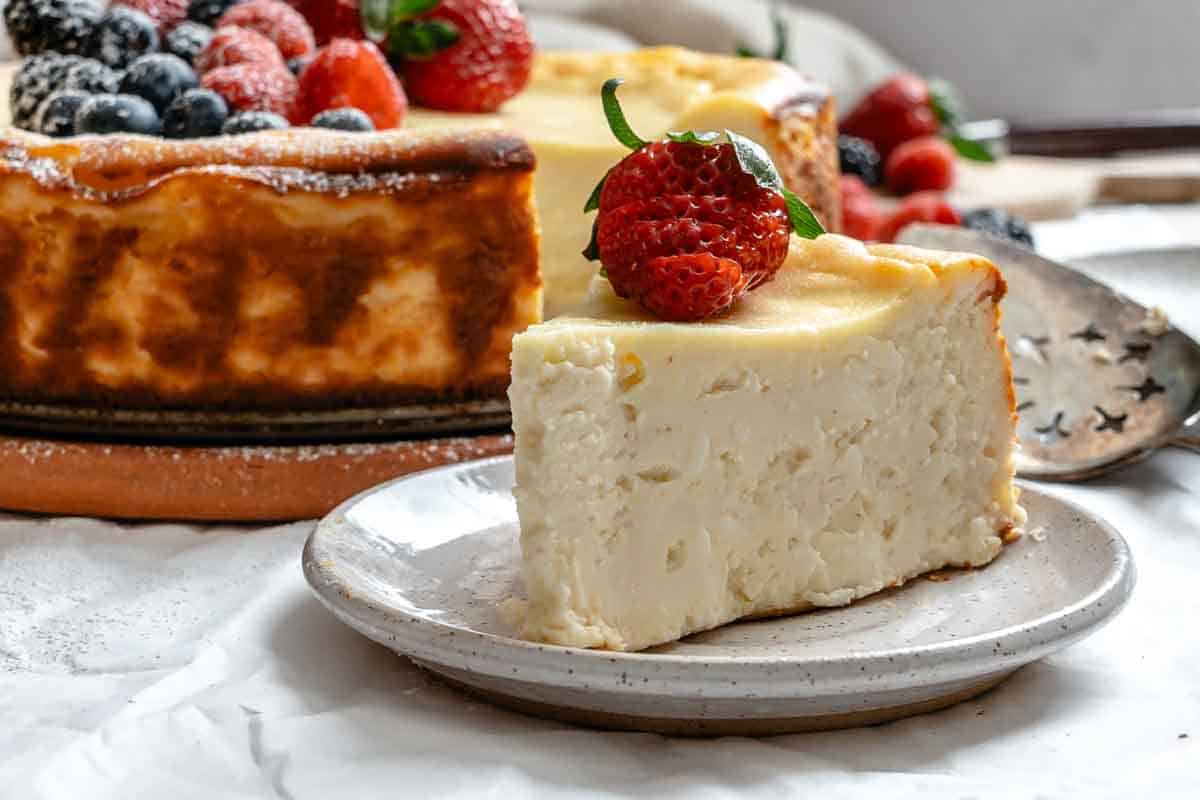
FAQ
This happens when ingredients aren't at room temperature or the ricotta mixture isn't properly blended. Processing in a food processor can help create a smoother texture.
Whole milk ricotta cheese produces the best texture. I don't recommend replacing it since other variations contain too much liquid and this affects the final result.
This can happen from overmixing, temperature shock, or overbaking. Traditional cheesecake often requires some baking time in a water bath, but our slow cooling prevents cracking. Even if your cheesecake cracks, it will still taste amazing!
Absolutely! Use a crust made of graham crackers or cookie crumbs mixed with a few melted tablespoons of butter.
Did you LOVE this recipe? Please leave a star ⭐️ rating and comment and tag your creations @ColeyCooks on Instagram!
Want to Save This Recipe?
Enter your email & I'll send it to your inbox.
By submitting this form, you consent to receive emails from Coley Cooks.
Italian Ricotta Cheesecake
Ingredients
- Butter or cooking spray for greasing
- 16 oz cream cheese 2 8-oz packages, softened to room temperature
- 2 cups whole milk ricotta cheese 1 pint
- 1 ½ cups granulated sugar
- 4 large eggs room temperature
- 1 tablespoon freshly squeezed lemon juice
- 1 tablespoon vanilla extract
- 3 tablespoons cornstarch
- 3 tablespoons all purpose flour
- ½ cup butter 1 stick, melted and cooled
- 2 cups sour cream 1 pint
- Berries whipped cream or powdered sugar, for serving (optional)
Instructions
- Preheat the oven to 350°F. Grease the bottom and sides of a 9-inch springform pan with softened butter or cooking spray.
- In a large bowl, use an electric mixer or stand mixer to beat the cream cheese and ricotta together until smooth.
- Add the sugar, eggs, lemon juice, vanilla, cornstarch, flour, melted butter, and sour cream. Mix until just combined and completely smooth—do not overmix or whip too much.*
- Pour the batter into the prepared pan and smooth the top. Gently tap the pan on the counter a few times to release any air bubbles.
- Bake for 1 hour. The center of the cake will still be quite jiggly.
- Turn off the oven and leave the cake inside with the door closed for 1 additional hour.
- Remove from the oven and let cool completely at room temperature. Then chill for at least 8 hours (overnight is best).
- Release the springform pan and carefully remove the cheesecake. If needed, dip a knife in hot water and run it around the edges to help loosen it.
- Slice and serve with fresh berries, whipped cream, and/or a dusting of powdered sugar.
Notes
- Ensure all ingredients are at room temperature. Cold ingredients create lumps.
- Don't over whip after you incorporate eggs to avoid adding too much air.
- Chill thoroughly overnight before slicing.
- Wipe your knife between slices for cleaner cuts.


